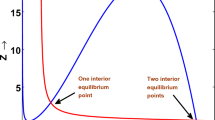Summary
The signal value of 4 distinct discharge patterns inGymnotus carapo was investigated by means of a model electric fish. The model produced an electrical approximation to theGymnotus discharge and field but bore no physical resemblance to the real animal (Figs. 1, 2). Three of the sequences used: Bursts, Offs and Shifts (Fig. 3) were simulations of patterns known to be involved in the agonistic behaviour ofGymnotus. The fourth was that characteristic of a resting fish and was used as a control.
-
1.
No aggressive behaviour was shown towards the model when it was electrically inactive. Components directed to the head region during normal interaction (Head Butt, Bite, etc.) were invariably directed to the electrical “head” of the otherwise symmetrical model. Polarity inversion resulted in a corresponding reversal of the end attacked.
-
2.
Comparison of the frequency distributions and rate of occurrence of behaviour components during interaction with the model and conspecifics revealed great similarity-the differences found being due to the immobility of the model (Fig. 4).
-
3.
A repeated measures analysis of variance (AOV) was used to examine the 6 replications of the experiment. The factors in the analysis were: Playback Sequence (Conditions), Amplitude (Level), Dominance and Days. Two groups of agonistic components, Approaches and Contacts were examined.
-
4.
The Days factor was significant for Contact scores only, due to the rapid habituation of high intensity (Contact) components; Approach scores remained at the same level (Fig. 5).
-
5.
Animals in a given dominance group showed the highest level of aggression towards the model when the amplitude was closest to their own (Fig. 6).
-
6.
High score for dominant and low for submissive in the Shifts condition, compared with the control, suggest that this is a “dominance” signal.
-
7.
Contact scores in the Offs condition were very low (Fig. 7) while Approaches remained at a high level (Fig. 6)-demonstrating the extreme effectiveness of the Off as a submissive signal.
-
8.
Contact scores in the Bursts condition showed a highly significant difference for the dominant group between the two playback amplitudes. Highest scores were for high level playback, the fish showing little interest in an apparently small fish (low amplitude) behaving aggressively (producing Bursts). These scores were even lower than for submissive animals at either amplitude (Fig. 7).
Similar content being viewed by others
References
Bennett, M. V. L., Grundfest, H.: Electrophysiology of electric-organ inGymnotus carapo. J. gen. Physiol.42, 1067–1104 (1959)
Black-Cleworth, P. A.: The role of electrical discharge in the non-reproductive social behaviour ofGymnotus carapo. Anim. Behav. Monogr.3, 1–77 (1970)
Box, H. O., Westby, G. W. M.: Behaviour of electric fish (Gymnotus carapo) in a group membership experiment. Psychonom. Sci.21, 27–28 (1970)
Bullock, T. H., Hamstra, R. H., Scheich, H.: The jamming avoidance response of high frequency electric fish. I. General features. J. comp. Physiol.77, 1–22 (1972)
Hopkins, C. D.: Sex differences in electric signalling in an electric fish. Science176, 1035–1037 (1972)
Moller, P.: “Communication” in weakly electric fish,Gnathonemus niger (Mormyridae). I. Variation of electric organ discharge frequency elicited by controlled electric stimuli. Anim. Behav.18, 768–786 (1970)
Moller, P., Bauer, R.: “Communication” in weakly electric fish.Gnathonemus petersii (Mormyridae). II. Interaction of electric organ discharge activities of two fish. Anim. Behav.21, 501–512 (1973)
Pecke, H. V. S., Peeke, C. S.: Habituation of conspecific aggression responses inBetta splendens. Behaviour36, 232–245 (1970)
Szabo, T., Suckling, E. E.: L'arrêt occasionel de la décharge électrique continue duGymnarchus, est-il une réaction naturelle ? Naturwissenschaften51, 92 (1963)
Valone, J. A.: Electrical emissions inGymnotus carapo and their relation to social behaviour. Behaviour37, 1–14 (1970)
Watanabe, A., Takeda, K.: The change of discharge frequency by AC stimulus in a weak electric fish. J. exp. Biol.40, 57–66 (1963)
Westby, G. W. M.: Electric signalling and social behaviour in gymnotid fish. Ph. D. Thesis; Reading, England; University of Reading (1972)
Westby, G. W. M.: Comparative studies of the aggressive behaviour of two gymnotid fish (Gymnotus carapo andHypopomus artedi) Anim. Behav. (in press, 1974a)
Westby, G. W. M.: Further analysis of the individual discharge characteristics predicting social dominance in the electric fish,Gymnotus carapo. Anim. Behav. (in press, 1974b)
Westby, G. W. M., Box, H. O.: Prediction of dominance in social groups of the electric fish,Gymnotus carapo. Psychonom. Sci.21, 181–183 (1970)
Winer, B. J.: Statistical principles in experimental design. London: McGraw-Hill 1970
Author information
Authors and Affiliations
Additional information
The author is indebted to the Science Research Council (U.K.) for financial support. The work forms part of a Ph. D. thesis presented at the University of Reading.
Rights and permissions
About this article
Cite this article
Max Westby, G.W. Assessment of the signal value of certain discharge patterns in the electric fish,Gymnotus carapo, by means of playback. J. Comp. Physiol. 92, 327–341 (1974). https://doi.org/10.1007/BF00696619
Received:
Issue Date:
DOI: https://doi.org/10.1007/BF00696619




